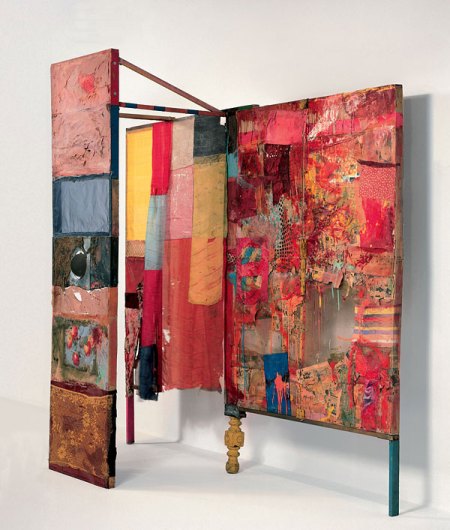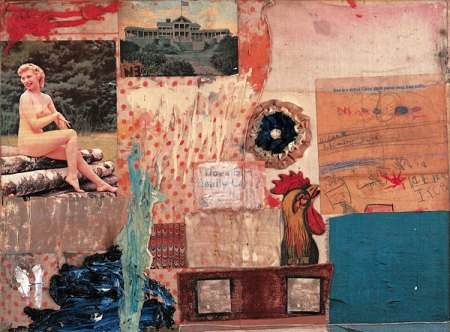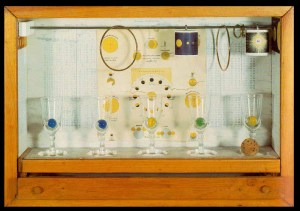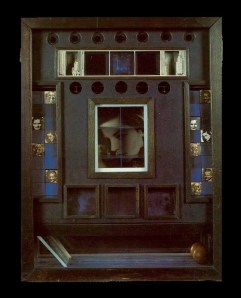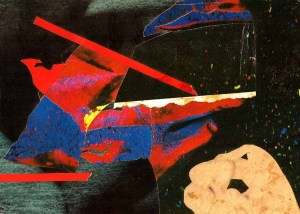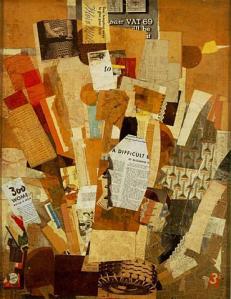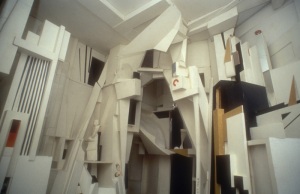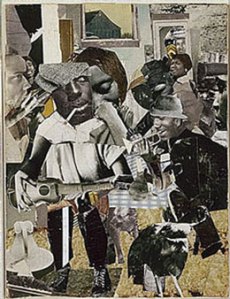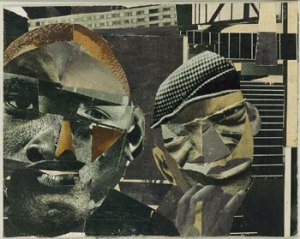In the wake of the invention of collage by Braque and Picasso, as well as that of Dadaist assemblage, Rauschenberg reinvented these practices, giving them new impact in his Combines. A child of Dada, Rauschenberg was influenced by the assemblages of Kurt Schwitters, whose example led him to suggest that art and life are but one. Nevertheless, as Barbara Rose has pointed out, Rauschenberg’s art drew its inspiration from the America of that era, and the artist was reacting against Abstract Expressionism and its goal of the absolute when he incorporated images from magazines or non-artistic materials into his works. As with any great artist, the influences on his work can be sought far afield; among the painters who have marked him profoundly, the artist cites Leonardo da Vinci and his Annunciation (1475-1478) at the Uffizi Gallery in Florence. “Since his painting is life, the tree, the rock, the Virgin are all given the same importance at the same time. There is no hierarchy. This is what interests me.” (Interview with André Parinaud, op.cit.) The same can be said of the Combines, where each element maintains its own integrity without obscuring the others. The present and the past, press photos or reproductions of masterpieces of Western art, drawing and painting, cushions and boxes are incorporated into his works, as they attempt to introduce “totality into the moment.”
As the name suggests, the Combines are hybrid works that associate painting with collage and assemblage of a wide range of objects taken from everyday life. Neither paintings nor sculptures, but both at once, Rauschenberg’s Combines invade the viewers’ space, demanding their attention, like veritable visual puzzles. From stuffed birds to Coca-Cola bottles, from newspaper to press photos, fabric, wallpaper, doors and windows, it is as though the whole universe enters into his combinatorial process to join forces with paint. A friend of John Cage, Rauschenberg also took an interest in sound, and in his later Combines, he developed analogies between music and visual arts. Through his affinity with Merce Cunningam and dance, some of his works became stage décors.
Minutiae ( 1954. Oil, paper, fabric, newspaper, wood, metal, plastic with mirror on wooden structure. ) is one of the first and most important freestanding Combine paintings. Designed for a dance performance for his friend Merce Cunningham, the work is from the outset at the centre of life. It consists of three vertical panels of different sizes, connected to each other.
As in all the Combines paintings, the surface is irregular, covered with newspaper clippings of comic strips, old photos and pieces of posters. Paint covers the entire piece, in the form of drips or colored surfaces. Between the panels is a passage in which a multicolored fabric curtain serves as the element joining the different parts. This fabric, attached to the top of the panels, allows the dancers to pass through. Wood, metal, plastic, and a mirror mingle in this composition dominated by reds, yellows and blues. On the left panel is a curious plant motif, as if thrown there with a few brush strokes and almost intact in its pictorial vivacity, resembling an ancient fresco from Pompeii, which attracts the viewer’s attention, by suddenly introducing an element from another time and place.
All at once a screen, a stage prop and a painting, this Combine painting presents itself as an open structure. Requiring more than a simple glance, this work does not demand the multiplicity of viewpoints, but the “multiplication of gazes”, as Catherine Millet has noted, adding that the Combines incite us to pass freely through the work. (“Le corps morcelé de la sculpture, Robert Rauschenberg” [The divided body of sculpture, Robert Rauschenberg] in Art Press, no. 90, March, 1985.)
Untitled, 1955
(Combine painting
Oil, crayon, pastel, paper, fabric, print reproductions, photographs and cardboard on wood.)Titles are of much importance to Rauschenberg. “They are all starting points. They are there when I begin my work, either I try to be consciously provocative or funny or macabre… The title is like another object in the work. It’s a deliberately solid and complex thought that obliges you to circle about the pieces, since because of them, you have the impression of never being in the right place.” (Interview of Robert Rauschenberg by Catherine Millet and Myriam Salomon, in Art Press, no. 65, December, 1982).
Therefore, when the artist calls a work Untitled, he gives full force to the absence of a title. There is no prior entry into the subject of the painting that the viewer can grab hold of, no starting point to restrain the imagination. The viewer is left alone to face the sensitive and open experience of the work. “If you talk too much about it, you see nothing. My work is made to be seen,” the artist has declared. The viewer is confronted here with a work that requires an examination, piece by piece, of the different elements that compose it, but without the artist insisting that one element has any meaning with respect to another. For what Rauschenberg wanted to do was to create paintings that “two people cannot see in the same way.” In reference to this, Catherine Millet has subtly emphasized that “Rauschenberg considers art as a means of individuation, opposed to everything in the social, ideological, political… or magical domain, that brings things together.” (Art Press, no. 90, op.cit). He does not seek community of the imagination. His art divides more than it assembles the immense catalogue of images, objects and things that are the world.
In this Combine, the artist juxtaposes images from magazines, photographs, fragments of posters, patterned fabric on which the paint slides. The image of a female nude sitting at an angle across tree trunks contrasts with the horizontal frontality of the building flying the American flag, while at the feet of the young woman a line of turquoise paint leads to a pool of blue.
This information is from the Centre Pompidou’s publication of Robert Rauschenberg Combines (1953-1964) thier exhibit from October 11 2006 through January 15, 2007.
I think a timeline post is needed her. Rauschenberg references so many artists and I’d like to make a post detailing these influences, especially since many of the references are to other collage artists.


